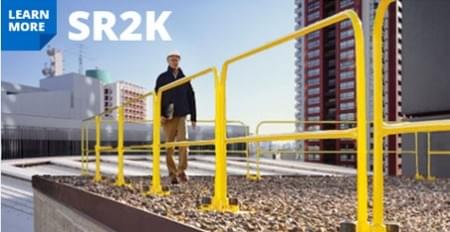Most people look forward to the longer, sunnier days of summer. But when it comes to working outside, especially on industrial rooftops, summer can pose a big threat. Heat, high humidity levels, and intense sunlight can not only damage your facility’s roof, they can also have a serious impact on employees working on the rooftop during summer months. Heat-related illnesses and accidents are a major concern.
Educating employees on heat safety, providing mandatory cool-down breaks, and implementing rooftop fall protection systems like safety rails are just a few of the ways to alleviate these potential problems. Before you expose your employees to the summer extremes, learn more about the damage the sun can do, and what you can do about it.
Regardless of the season, workers still need to carry out repairs, maintenance, and construction activities. Summer often is the most convenient time to get maintenance work done – less falling debris, wind, and inclement weather. Intense sunlight, high temperatures, and increased humidity, however, can cause health concerns, contribute to accidents, and can even lead to death. For your workers’ safety, its crucial to understand how summer weather affects the human body, and how to mitigate its effects.
Here are the top heat-related illnesses to look out for:
The onset of all of the above illnesses can be swift. It is of utmost importance that your employees do not go on the roof alone, and that you employ safety rails and other rooftop fall protection devices in the event of cramping, dizziness, and fainting.
More times than not, high heat and humidity levels don't stop work from being done. Proactive measures to improve employee's rooftop safety must be both a priority and mandatory before any work begins. To keep your workers’ healthy and safe, make sure you:
 The rooftop of your facility protects your building’s structure from elemental damage. In turn, you need to protect your employees that go up there. More than likely, you’ll need to have employees on the roof at some point during the summer season. Following OSHA guidelines for rooftop safety, installing rooftop fall protection systems, and applying a little common sense goes a long way to ensuring workers stay safe and healthy.
The rooftop of your facility protects your building’s structure from elemental damage. In turn, you need to protect your employees that go up there. More than likely, you’ll need to have employees on the roof at some point during the summer season. Following OSHA guidelines for rooftop safety, installing rooftop fall protection systems, and applying a little common sense goes a long way to ensuring workers stay safe and healthy.
Providing adequate rooftop safety for your workers is not just the right thing to do, it’s your legal obligation. By addressing this important issue ahead of time, your company, building, and employees will be well-protected for years to come.